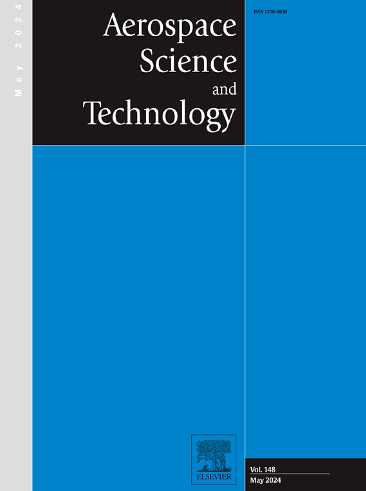Studying body-freedom flutter mechanism via a rigid-elastic aeroelastic model of reduced-order
IF 5
1区 工程技术
Q1 ENGINEERING, AEROSPACE
引用次数: 0
Abstract
The paper presents a rigid-elastic aeroelastic model of reduced-order for a flying-wing aircraft to reveal the interaction mechanism of a body-freedom flutter and optimize the structural parameters at the initial design stage of the flying-wing aircraft. The model proposed includes the effect of the sweep-back angle, the aerodynamic forces of the wing and fuselage, and the structural dynamics. To verify the accuracy of the model, the paper offers numerical simulations of body-freedom flutter characteristics compared with the flight tests of a flying-wing aircraft. Then, the paper addresses the interaction mechanism of body-freedom flutter by combining the flight test phenomenon with the simplified model from a modal perspective and gives the consequence of related structural parameters on the body-freedom flutter for guidance in a structural design. The results indicate that the short-period mode, plunge mode, bending mode, and torsion mode of the aircraft played a joint role in the body-freedom flutter analysis. In addition, the sweep-back angle and the centers of gravity had significant influenced on the static stability of the aircraft, and the stability transition in the static equilibrium point was extremely rapid and dangerous.
本文提出了飞行翼飞机的减阶刚弹性气动弹性模型,以揭示体自由扑翼的相互作用机理,并在飞行翼飞机的初始设计阶段优化其结构参数。所提出的模型包括后掠角的影响、机翼和机身的气动力以及结构动力学。为了验证模型的准确性,论文提供了与飞翼飞机飞行测试相比较的体自由扑翼特性数值模拟。然后,论文从模态角度出发,将飞行试验现象与简化模型相结合,探讨了体自由度扑动的相互作用机理,并给出了相关结构参数对体自由度扑动的影响,以指导结构设计。结果表明,飞机的短周期模态、垂尾模态、弯曲模态和扭转模态在体自由扑动分析中共同发挥作用。此外,后掠角和重心对飞机的静态稳定性也有显著影响,静态平衡点的稳定性转换极为迅速和危险。
本文章由计算机程序翻译,如有差异,请以英文原文为准。
求助全文
约1分钟内获得全文
求助全文
来源期刊

Aerospace Science and Technology
工程技术-工程:宇航
CiteScore
10.30
自引率
28.60%
发文量
654
审稿时长
54 days
期刊介绍:
Aerospace Science and Technology publishes articles of outstanding scientific quality. Each article is reviewed by two referees. The journal welcomes papers from a wide range of countries. This journal publishes original papers, review articles and short communications related to all fields of aerospace research, fundamental and applied, potential applications of which are clearly related to:
• The design and the manufacture of aircraft, helicopters, missiles, launchers and satellites
• The control of their environment
• The study of various systems they are involved in, as supports or as targets.
Authors are invited to submit papers on new advances in the following topics to aerospace applications:
• Fluid dynamics
• Energetics and propulsion
• Materials and structures
• Flight mechanics
• Navigation, guidance and control
• Acoustics
• Optics
• Electromagnetism and radar
• Signal and image processing
• Information processing
• Data fusion
• Decision aid
• Human behaviour
• Robotics and intelligent systems
• Complex system engineering.
Etc.
 求助内容:
求助内容: 应助结果提醒方式:
应助结果提醒方式:


